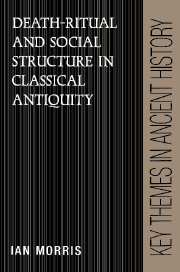Book contents
- Frontmatter
- Contents
- List of figures
- List of tables
- Preface
- Abbreviations
- 1 Map of sites in the Roman empire discussed in this book
- 2 Map of sites in Greece discussed in this book
- 1 The anthropology of a dead world
- 2 ‘Mos Romanus’: cremation and inhumation in the Roman empire
- 3 ‘Dem bones’: skeletal remains
- 4 Taking it with you: grave goods and Athenian democracy
- 5 Monuments to the dead: display and wealth in classical Greece
- 6 Famous last words: the inscribed tombstone
- 7 At the bottom of the graves: an example of analysis
- 8 Conclusion
- Bibliographical essay
- Bibliography
- Index
7 - At the bottom of the graves: an example of analysis
Published online by Cambridge University Press: 02 December 2009
- Frontmatter
- Contents
- List of figures
- List of tables
- Preface
- Abbreviations
- 1 Map of sites in the Roman empire discussed in this book
- 2 Map of sites in Greece discussed in this book
- 1 The anthropology of a dead world
- 2 ‘Mos Romanus’: cremation and inhumation in the Roman empire
- 3 ‘Dem bones’: skeletal remains
- 4 Taking it with you: grave goods and Athenian democracy
- 5 Monuments to the dead: display and wealth in classical Greece
- 6 Famous last words: the inscribed tombstone
- 7 At the bottom of the graves: an example of analysis
- 8 Conclusion
- Bibliographical essay
- Bibliography
- Index
Summary
A realist, he has always said
‘It is Utopian to be dead
For only on the Other Side
Are Absolutes all satisfied
Where, at the bottom of the graves
Low Probability behaves.’
W. H. Auden, New Year LetterThis is a poem that archaeologists are fond of quoting; my excuse for using it is that it is peculiarly relevant to the problems discussed in this chapter. So far, I have looked at grand themes: how burials, in context, help us understand the rise of the polis, democratic Athens, the fall of Rome. I have tried to show that burials are worth study. Now I will give an example of how study can proceed at a much more detailed level. I end not with a bang but with a whimper: no all-embracing model of antiquity in ten pages, but a blow-by-blow analysis of Vroulia, a small site at the southern tip of Rhodes (fig. 40).
Vroulia may seem an odd choice for a closing example. It was excavated in 1907–8 and the site report, published in 1914, is not easy to find. The demographic data are scanty and the textual sources available from Rhodes in the period the site was occupied, c. 625–575 b.c., are worse. Further, the site report itself is in many ways ‘pre-modern’, lacking the conventions which nowadays define authoritative archaeological discourse. But some of these failings are actually advantages for my purposes. Much of the archaeologist's energy goes into interpreting the silences and contradictions of site reports, a complex genre which has to be read as closely as any ancient text.
- Type
- Chapter
- Information
- Death-Ritual and Social Structure in Classical Antiquity , pp. 174 - 199Publisher: Cambridge University PressPrint publication year: 1992



